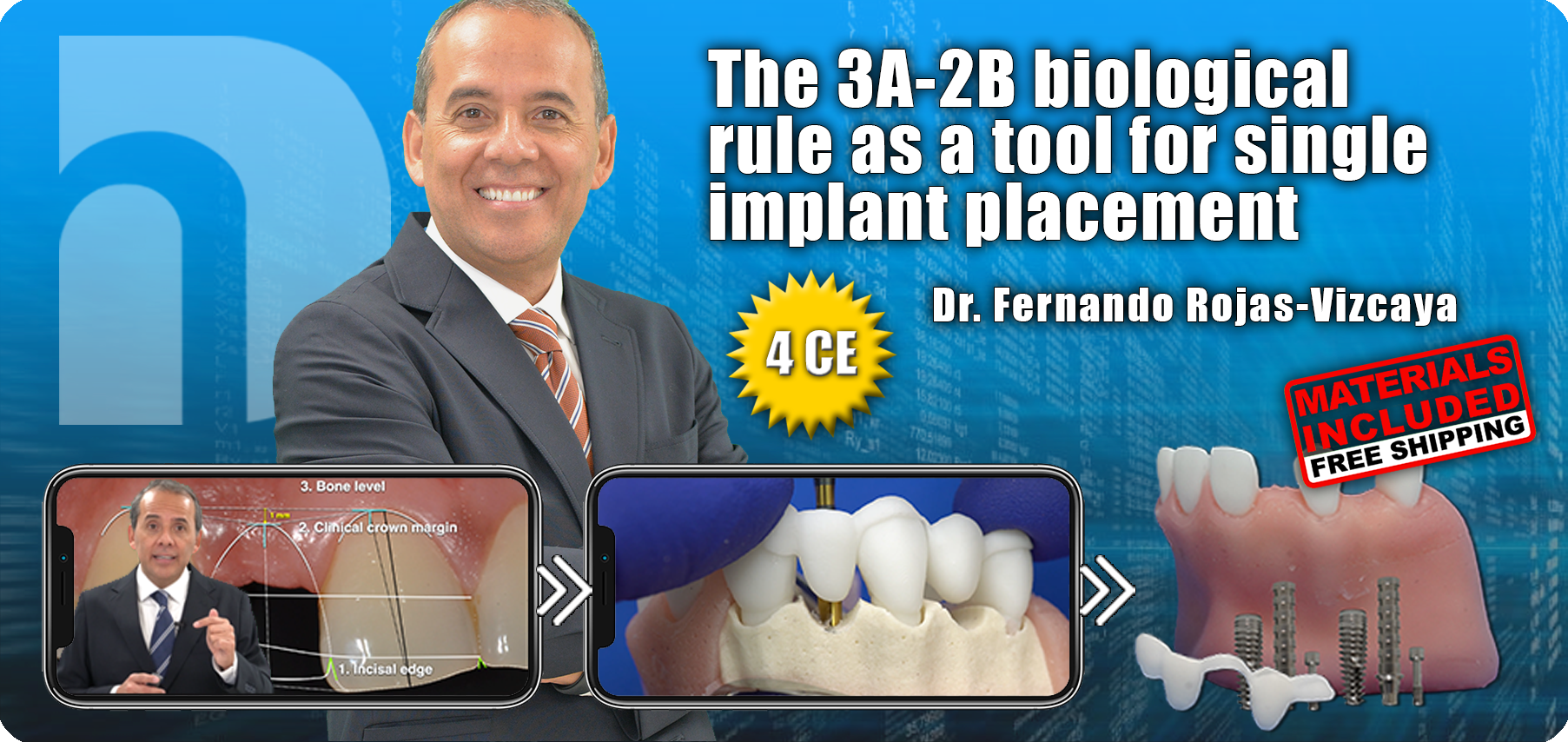The 3A-2B rule as a tool for single implant placement
 General Information
General Information
Date: Published on 25/11/21
Last Review: 14/06/24
Location: Online
Teaching method: Self-instructional (The student will have the opportunity to watch the pre-recorded lecture, the pre-recorded workshop, and then practice at home with the materials that we will send him)
Continuing Educational Credits Awarded: 4CE
Dentalhow.online is an ADA CERP Recognized Provider.
ADA CERP is a service of the American Dental Association to assist dental professionals in identifying quality providers of continuing dental education. ADA CERP does not approve or
endorse individual courses or instructors, nor does it imply acceptance of credit hours by boards of dentistry.
Dentalhow.online designates this activity for 4 continuing education credits.
*You can watch the lecture & workshops as many times as you want, there isn’t any kind of expiration date*
Dr. Fernando Rojas-Vizcaya has no conflicts of interest related to this course. He does not have any relevant financial relationships to declare.
If you wish to ask a question, share a clinical case relevant to the course topic, or request additional information regarding the scientific content, please feel free to contact us at info@dentalhow.online.
If you require any technical assistance or support, please send us a message using the green chat box located on the right side of the main screen. This will connect you directly to our WhatsApp number, where our team will assist you promptly.
 Abstract
Abstract
Placing dental implants at the level of the existing bone doesn’t guarantee that the aesthetic and corresponding biological function will be obtained when making the final restoration.
In fact, cases with dental implants must be prosthetically planned, guided, and executed. For this reason, before placing the implants, it is necessary to determine the 3D position of the new teeth and then apply the 3A-2B biological rule.
The dental implant should be placed 3 mm in an apical direction (3A) from the margin of the planned crown to maintain the biological space, and 2 mm of buccal bone should be kept to prevent reabsorption (2B). Its application will determine if the existing bone level is correct, or on the contrary, if it is necessary to add or remove the bone.
This course presents the concept and how to apply it in single or multiple implant cases.
The 3A-2B rule will be applied in a maxillary lateral incisor and a first premolar during the pre-recorded workshop. After placing the two implants, the immediate provisionalization will be made, and the aesthetic results and the integration between the prosthesis and the biology will be seen.
 Learning objectives
Learning objectives
- First, know how to plan single implant cases from the prosthodontist’s perspective
- Second, understand when it’s necessary to reduce the bone, increase it or not modify it
- Third, understand the relationship between the planned crown margin, bone, and the biological space
- Fourth, how to perform the osteotomy when it is a prosthetic indication
- Fifth, understand the use of the rule in full-arch cases
 Course Content
Course Content
- Online Pre-recorded lecture | 1 h 25 min
- Online Pre-recorded workshop | 1 h 21 min
- Customized BoneModel (BM)
- Surgical Guide/Provisional restorations
- BM Manual Wrench
- Two BM Steel 4 x 13 mm Demo Implants
- Two BM Steel Demo Screws
- Two BM Steel Demo Temporary Abutments
IMPORTANT – Experience in this area is recommended to ensure a good understanding of the course content.
DIFFICULTY – MEDIUM
*To place the implants is necessary any surgical kit with drills for 4 x 13 mm implants (THESE ARE NOT INCLUDED)*
*To work with the fixation screws is necessary a standard hex screwdriver (1.3 mm) (IT IS NOT INCLUDED)*
*We only send the components specified in the “Do It” segment, the rest of the material needed to perform the workshop (such as drills, blades, sutures, etc) will be provided by the student*
*All the demo components are produced by BoneModels only to be used on models. “THE DEMO COMPONENTS ARE NOT SUITABLE FOR HUMAN USE”*
*TAXES AND SHIPPING INCLUDED*
 Why should I take this course?
Why should I take this course?
Improved implant placement accuracy: Knowledge and use of the 3A-2B rule can help dental professionals improve the accuracy of their implant placement, and the understanding of the need of bone reduction due to prosthetic requirements, leading to better outcomes for their patients.
Increased patient satisfaction: By using the 3A-2B rule as a tool, dental professionals can ensure that their patients receive high-quality treatment with optimal functional, and aesthetic outcomes, leading to increased patient satisfaction.
Competitive differentiation: By possessing specialized knowledge in the use of the 3A-2B rule, dental professionals can differentiate themselves from their competition and attract more patients who are seeking quality treatment.
Streamlined treatment planning: The 3A-2B rule can help dental professionals streamline the treatment planning process and make it more efficient, allowing them to spend more time with their patients.
Improved patient safety: Proper use of the 3A-2B rule can improve patient safety during implant placement, reducing the risk of complications and ensuring optimal outcomes for the patient.





